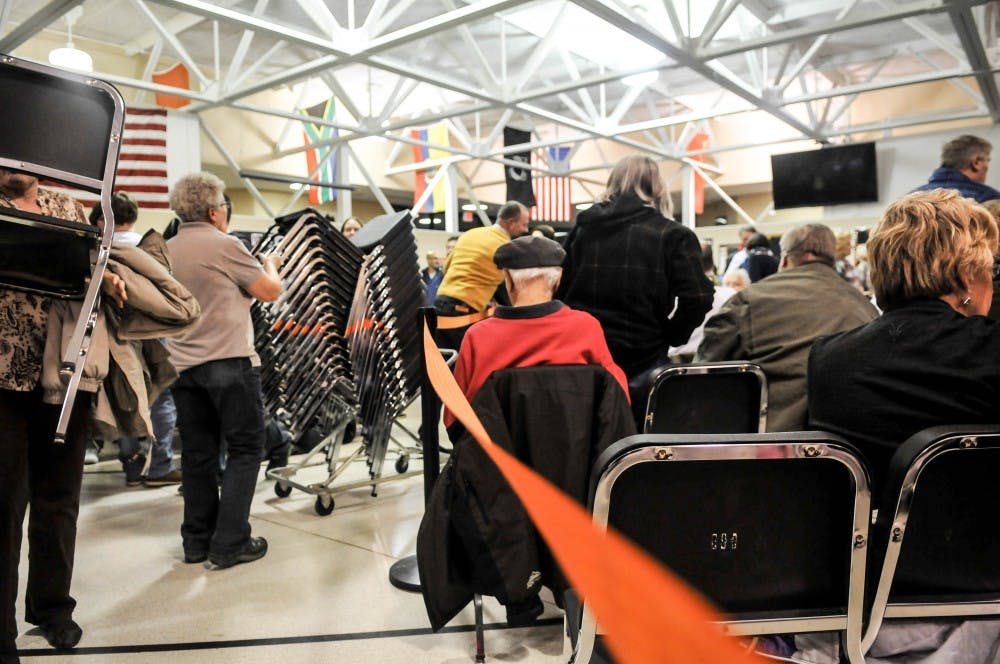
An orange rope helped divide the supporters of different candidates at the Democratic caucus in Clive, IA.
Credit: Amanda SuarezCLIVE, IOWA — Just after the first round of votes had been counted, Ben Swartz knew he would have to make a choice: his wife or Bernie Sanders.
At a crowded caucus at Indian Hills Junior High School — a few miles outside of Des Moines — Swartz joined 336 other Democrats in the annual first-in-the-nation Iowa caucus, famous as much for its byzantine rules and procedures as it is for its early date.
In order for a Democratic candidate’s votes to count, their supporters must collect at least 15 percent of the supporters in an individual precinct. Only 17 other Iowans in the Clive-3 precinct supported former Maryland Gov. Martin O’Malley, meaning those unlucky Iowans had to either switch their vote or have them not count.
In New Hampshire or South Carolina — the two primaries to follow in consecutive weeks — voters like Swartz and his wife, Joyce, could have voted for their preferred candidates in private. No hassle or public pressure necessary. Not the case here in Iowa.
“My wife may kill me,” he said after replacing his O’Malley sticker with a Sanders one. Hours later, O’Malley would suspend his campaign after yielding less than one percent of the statewide vote. To her credit, Joyce seemed hardly coercive, only playfully motioning to her husband from across the yellow rope dividing Sanders and Clinton caucus-goers.
Such is the weird majesty of the Iowa caucuses, where private politics become public.
“Iowans take this seriously,” Tom Whitney, the founder of the first-in-the-nation caucus system, said in an interview after the Clive-3 caucus-goers finished. As chairman of the Iowa Democratic Party in 1973, Whitney advocated for the caucus system as an antidote to the insular nomination process of years past.
Having candidates reach a threshold of viability — an almost immediate disqualifier to distant third-place candidates like O’Malley — was necessary, Whitney said, to eliminate frivolous campaigns.
“You wanted something to show that they’re viable candidates who are seriously seeking the presidency,” he said.
Inside the middle school, Clinton and Sanders supported chanted, sang and occasionally even bribed O’Malley’s voters to switch sides. Election officials allowed each group to give a short speech in favor of their candidate before the wheeling-and-dealing began.
O’Malley precinct captain Barb Appleby offered a gorgeous-looking tin of homemade chocolate-chip cookies, but failed to convert any other caucus-goers. Unlike Swartz, she chose not to switch her vote.
Neither did Arthur Niels, who stayed put in the O’Malley corner even after precinct officials declared his votes inviable.
“There are two candidates here that are not electable,” he said, pointing out the scandal over Clinton’s private email server and the “totally off the map” policy goals favored by Sanders.
Clive-3 precinct is one of the largest precincts in Polk County, the largest county in Iowa. Over 20 percent of the 44 delegates available in the Democratic caucus were up for grabs in that Indian Hills Junior High gym. When all the voters were counted — and they were painstakingly counted one by one — Hillary had taken six delegates, Sanders three. The results were closer statewide with Clinton and Sanders virtually tied by 11:30 p.m. EST.
After the votes were counted, the divider ropes came down and neighbors, friends and spouses joined hands again and proceeded home. With that, the anachronistic treasure of American politics again ran its course.
The Daily Pennsylvanian is an independent, student-run newspaper. Please consider making a donation to support the coverage that shapes the University. Your generosity ensures a future of strong journalism at Penn.
DonatePlease note All comments are eligible for publication in The Daily Pennsylvanian.





